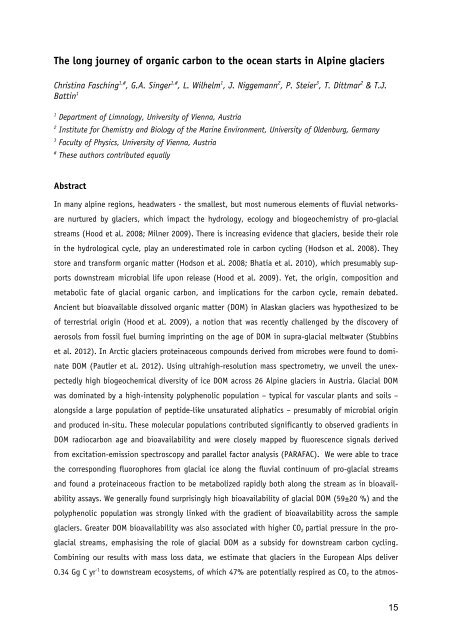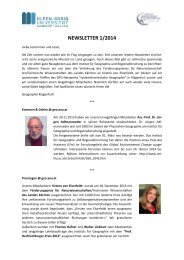Geographica Augustana - Institut für Geographie und ...
Geographica Augustana - Institut für Geographie und ...
Geographica Augustana - Institut für Geographie und ...
Sie wollen auch ein ePaper? Erhöhen Sie die Reichweite Ihrer Titel.
YUMPU macht aus Druck-PDFs automatisch weboptimierte ePaper, die Google liebt.
The long journey of organic carbon to the ocean starts in Alpine glaciersChristina Fasching 1,# , G.A. Singer 1,# , L. Wilhelm 1 , J. Niggemann 2 , P. Steier 3 , T. Dittmar 2 & T.J.Battin 11 Department of Limnology, University of Vienna, Austria2 <strong>Institut</strong>e for Chemistry and Biology of the Marine Environment, University of Oldenburg, Germany3 Faculty of Physics, University of Vienna, Austria# These authors contributed equallyAbstractIn many alpine regions, headwaters - the smallest, but most numerous elements of fluvial networksarenurtured by glaciers, which impact the hydrology, ecology and biogeochemistry of pro-glacialstreams (Hood et al. 2008; Milner 2009). There is increasing evidence that glaciers, beside their rolein the hydrological cycle, play an <strong>und</strong>erestimated role in carbon cycling (Hodson et al. 2008). Theystore and transform organic matter (Hodson et al. 2008; Bhatia et al. 2010), which presumably supportsdownstream microbial life upon release (Hood et al. 2009). Yet, the origin, composition andmetabolic fate of glacial organic carbon, and implications for the carbon cycle, remain debated.Ancient but bioavailable dissolved organic matter (DOM) in Alaskan glaciers was hypothesized to beof terrestrial origin (Hood et al. 2009), a notion that was recently challenged by the discovery ofaerosols from fossil fuel burning imprinting on the age of DOM in supra-glacial meltwater (Stubbinset al. 2012). In Arctic glaciers proteinaceous compo<strong>und</strong>s derived from microbes were fo<strong>und</strong> to dominateDOM (Pautler et al. 2012). Using ultrahigh-resolution mass spectrometry, we unveil the unexpectedlyhigh biogeochemical diversity of ice DOM across 26 Alpine glaciers in Austria. Glacial DOMwas dominated by a high-intensity polyphenolic population – typical for vascular plants and soils –alongside a large population of peptide-like unsaturated aliphatics – presumably of microbial originand produced in-situ. These molecular populations contributed significantly to observed gradients inDOM radiocarbon age and bioavailability and were closely mapped by fluorescence signals derivedfrom excitation-emission spectroscopy and parallel factor analysis (PARAFAC). We were able to tracethe corresponding fluorophores from glacial ice along the fluvial continuum of pro-glacial streamsand fo<strong>und</strong> a proteinaceous fraction to be metabolized rapidly both along the stream as in bioavailabilityassays. We generally fo<strong>und</strong> surprisingly high bioavailability of glacial DOM (59±20 %) and thepolyphenolic population was strongly linked with the gradient of bioavailability across the sampleglaciers. Greater DOM bioavailability was also associated with higher CO 2 partial pressure in the proglacialstreams, emphasising the role of glacial DOM as a subsidy for downstream carbon cycling.Combining our results with mass loss data, we estimate that glaciers in the European Alps deliver0.34 Gg C yr -1 to downstream ecosystems, of which 47% are potentially respired as CO 2 to the atmos-15



